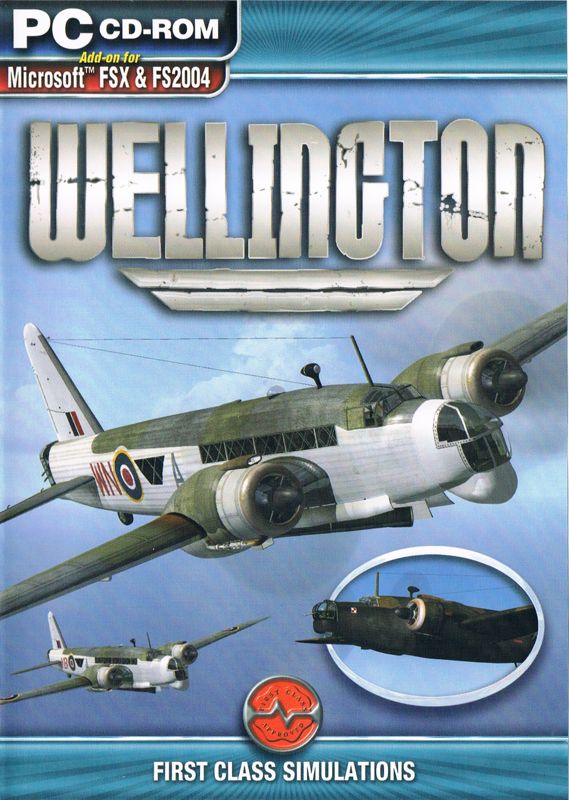Retro Replay Review
Gameplay
The Wellington expansion for Microsoft Flight Simulator 2004 and Flight Simulator X delivers a deeply immersive flight experience centered around one of WWII’s most iconic bombers. From the moment you taxi out at RAF Driffield circa 1941, the expansion immerses you in the day-to-day operations of a Wellington crew. Whether you’re lining up on the runway for a practice takeoff or climbing toward cruising altitude under a full bomb load, the flight model remains consistently authentic and challenging. Novices will appreciate the included tutorial missions, while veterans can dive straight into the high-fidelity handling that demands precise throttle, flap, and mixture management.
(HEY YOU!! We hope you enjoy! We try not to run ads. So basically, this is a very expensive hobby running this site. Please consider joining us for updates, forums, and more. Network w/ us to make some cash or friends while retro gaming, and you can win some free retro games for posting. Okay, carry on 👍)
One of the standout gameplay elements is the inclusion of four distinct Wellington variants: the MK IC, B. MkIII, B. MkX, and B. MkXIV. Each model feels uniquely weighted in the air, reflecting historical differences in armor, engines, and bomb bay configurations. Switching between variants showcases subtle changes in climb rate, top speed, and stall characteristics. This encourages replayability as you experiment with different payloads and mission profiles.
Complementing the aircraft themselves is the detailed RAF Driffield scenery, accurately laid out as it would have appeared in 1941. Taxiing between revetments, spotting period hangars, and lining up on the grass airstrip add a tangible sense of place to every sortie. The expansion doesn’t just drop you into empty airspace—it provides a living, breathing wartime airfield where every takeoff and landing feels meaningful.
Graphics
Visually, Wellington shines on both FS2004 and FSX platforms. The exterior model of each variant is rendered with meticulous attention to rivet lines, paint weathering, and the distinctive geodetic airframe pattern invented by Barnes Wallis. Reflections on the plexiglass nose, the resilience of the defensive gun turrets, and the realistic flaps and control surfaces all contribute to a convincing warbird presentation.
The cockpit textures are equally impressive, featuring authentic placards, scratch-worn metal panels, and period-correct instrument faces. Clickable controls are logically laid out, and instrument needles respond smoothly to changes in throttle, manifold pressure, and altitude. Cockpit lighting modes—ranging from blackout conditions to full interior illumination—enhance immersion, especially during nighttime or low-visibility operations.
RAF Driffield’s complimentary scenery complements the aircraft’s fidelity. Wartime buildings, taxiway markings, and perimeter defenses are all faithfully reproduced in 3D. The surrounding countryside displays realistic field boundaries and hedgerows, giving each flight a true sense of place. Even distant objects such as fuel dumps and barracks appear sharp, thanks to well-optimized texture work that balances visual quality with performance.
Story
While Wellington does not include a traditional narrative campaign, its historical backdrop speaks volumes. Players are invited to step into the shoes of RAF bomber crews during the critical early years of the air campaign. The choice of RAF Driffield circa 1941 is particularly evocative, as this station played a key role in training and home defense before the bomber offensive shifted east.
The variety of Wellington marks allows you to retrace the evolution of bomber technology during WWII. The MK IC’s nav-cum-bomb-aiming station, the B. MkIII’s improved defensive turrets, and the B. MkXIV’s more powerful Hercules engines each tell a chapter of wartime innovation. Simply selecting a different aircraft becomes a mini-history lesson, underlining how incremental design changes influenced effectiveness and crew survival rates.
Mission briefings—while not fully voiced—include historically accurate loadouts, typical flight altitudes, and target profiles. This, combined with the date-specific scenery and period-correct radio beeps, makes every sortie feel grounded in real events. For history buffs and sim enthusiasts alike, Wellington masterfully blends technical flight simulation with a palpable sense of 1940s RAF operations.
Overall Experience
As an expansion to two of Microsoft Flight Simulator’s most enduring editions, Wellington stands out for its dedication to authenticity and depth. It captures the essence of flying a geodetic-frame bomber without overwhelming newcomers. The balance of accessible training aids and advanced flight dynamics ensures both casual sim fans and serious virtual pilots can enjoy the package.
The combination of four distinct aircraft, the rich historical context, and the meticulously crafted RAF Driffield scenery makes Wellington more than just another add-on—it’s a comprehensive window into a pivotal era of aviation history. The attention to detail in both flight modeling and visuals rewards players who take the time to learn each variant’s quirks and best practices.
Whether you’re interested in practicing formation flying, honing night navigation skills, or simply soaking up period atmosphere, Wellington delivers a satisfying and memorable experience. For anyone looking to expand their collection of WWII flight simulations, this expansion is a must-have addition to Microsoft Flight Simulator 2004 or Flight Simulator X.
 Retro Replay Retro Replay gaming reviews, news, emulation, geek stuff and more!
Retro Replay Retro Replay gaming reviews, news, emulation, geek stuff and more!




Reviews
There are no reviews yet.